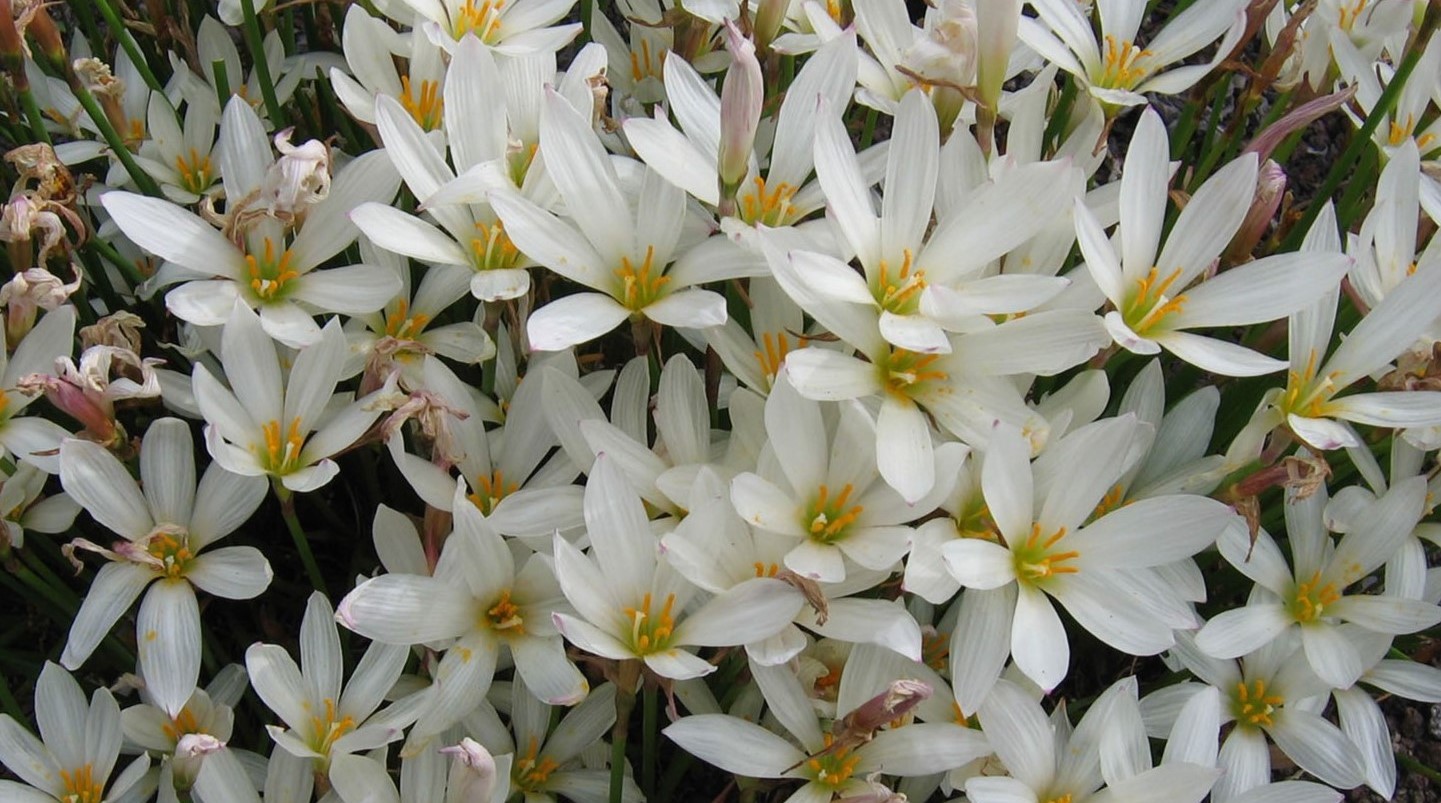
Are you fascinated by the beauty and wonder of plants? If so, get ready to discover some intriguing facts about Zephyranthes, a fascinating genus of flowering plants. Zephyranthes, also known as rain lilies or fairy lilies, are native to the Americas and are celebrated for their delicate blooms and resilience. In this article, we will delve into 17 captivating facts about Zephyranthes that will not only deepen your appreciation for these enchanting plants but also impress your friends with your newfound knowledge. From their unique life cycle and vibrant colors to their cultural significance and medicinal properties, Zephyranthes will undoubtedly amaze you in more ways than one. So, buckle up and prepare for a thrilling journey through the world of Zephyranthes!
Key Takeaways:
- Zephyranthes, also known as “fairy lilies” or “rain lilies,” bloom in vibrant colors after rainfall, attracting pollinators and symbolizing beauty and resilience in various cultures.
- These easy-to-grow, deer-resistant flowers have a rich history and have inspired artists and poets with their delicate and ethereal beauty, making them a captivating addition to any garden.
Zephyranthes blooms after rainfall.
One of the fascinating characteristics of Zephyranthes is their ability to bloom shortly after rainfall. These flowers emerge from the ground, displaying their vibrant colors and enchanting fragrance.
Zephyranthes come in various colors.
From pure white to shades of pink, yellow, and even red, Zephyranthes offers a wide range of colors to suit any garden palette. Their petals often have a delicate, star-shaped appearance.
Zephyranthes are native to the Americas.
These exquisite flowers are native to the Americas, specifically North, Central, and South America. They can be found in a variety of habitats, including grasslands, forests, and marshes.
They are part of the Amaryllidaceae family.
Zephyranthes belongs to the Amaryllidaceae family, which also includes other popular plants such as daffodils and snowdrops. This family is known for its beautiful floral displays.
Some Zephyranthes species have a spicy fragrance.
While not all Zephyranthes have a noticeable fragrance, some species emit a spicy or sweet scent, adding an extra dimension to their allure.
Zephyranthes are easy to grow.
Whether you are a novice or experienced gardener, Zephyranthes are relatively easy to grow. They prefer well-drained soil and thrive in sunny or partially shaded areas.
Zephyranthes are perennial plants.
These beautiful flowers are perennials, meaning they will come back year after year with proper care. This makes them a durable and beloved addition to any garden.
They can be propagated through bulbs or seeds.
Zephyranthes can be propagated through bulbs or seeds. Division of mature clumps is also a common method used by gardeners to expand their Zephyranthes collection.
Zephyranthes have grass-like foliage.
The foliage of Zephyranthes consists of slender, grass-like leaves that grow from the base of the plant. These leaves provide an elegant backdrop to the stunning flowers.
They attract pollinators.
The vibrant colors and sweet fragrance of Zephyranthes attract pollinators such as bees and butterflies, promoting biodiversity in your garden.
Zephyranthes have medicinal uses.
In some traditional medicine practices, Zephyranthes is believed to have medicinal properties. The bulbs and extracts of certain species are used for various purposes.
They are drought-tolerant plants.
While Zephyranthes appreciate regular watering, they are also known for their resilience in drought-like conditions. This quality makes them an excellent choice for arid regions.
Zephyranthes have a long blooming period.
Once they start blooming, Zephyranthes flowers can last for several weeks, providing an extended display of beauty in your garden.
They can be grown in containers.
Due to their small size and low maintenance needs, Zephyranthes can be successfully grown in containers, making them a versatile option for balconies or patios.
Zephyranthes are deer-resistant.
Deer tend to avoid Zephyranthes, making them a great choice for gardens in areas frequented by these browsing animals.
They have a rich cultural significance.
Zephyranthes holds cultural significance in many regions. In certain cultures, these flowers symbolize beauty, purity, and resilience.
Zephyranthes have inspired artists and poets.
The delicate and ethereal beauty of Zephyranthes has inspired artists, poets, and writers throughout history. Their enchanting presence often finds its way into various forms of artistic expression.
As we have explored these 17 intriguing facts about Zephyranthes, it is evident that these flowers have a captivating allure and a rich history. Whether adorning gardens, symbolizing emotions, or being a source of inspiration, Zephyranthes continues to mesmerize all who encounter their enchanting bloom.
Conclusion
In conclusion, Zephyranthes, also known as rain lilies, are fascinating plants that captivate with their delicate blooms and resilience. These plants have a rich history and offer a range of benefits, both aesthetic and ecological. From their ability to thrive in diverse environments to their vibrant colors and soothing fragrance, Zephyranthes are a remarkable addition to any garden or landscape.
Whether you are an experienced gardener or a beginner, Zephyranthes can be a great choice for enhancing the beauty of your outdoor space. With their easy maintenance and ability to attract pollinators, they bring life and joy to any scenery. So, consider incorporating Zephyranthes into your garden and experience the wonder and charm they bring.
FAQs
Q: How often do Zephyranthes bloom?
A: Zephyranthes typically bloom after rainfalls or heavy irrigation, usually every few weeks during the growing season.
Q: How tall do Zephyranthes plants grow?
A: Zephyranthes plants usually grow to be around 6 to 12 inches tall.
Q: Do Zephyranthes require full sun?
A: Yes, Zephyranthes thrive in full sun, although they can tolerate partial shade as well.
Q: Are Zephyranthes plants frost-tolerant?
A: Most Zephyranthes varieties are not frost-tolerant and require protection or bringing indoors during cold winter months.
Q: How do I care for Zephyranthes?
A: Zephyranthes prefer well-drained soil and moderate watering. They should be fertilized sparingly and divided every few years to maintain their vigor.
Q: Can Zephyranthes be grown in containers?
A: Yes, Zephyranthes can be successfully grown in containers, making them a versatile choice for balconies or small gardens.
Q: Are Zephyranthes plants toxic to pets?
A: Zephyranthes plants are considered non-toxic to pets, making them a safe option for households with cats or dogs.
Q: How do I propagate Zephyranthes?
A: Zephyranthes can be propagated through bulbs or seeds. Bulbs can be divided and replanted, while seeds can be collected and sown during the appropriate season.
Zephyranthes, also known as rain lilies or zephyr lilies, captivate gardeners and nature enthusiasts with their enchanting beauty and intriguing characteristics. From their ability to bloom after rainfall to their diverse color range, zephyr lilies never fail to mesmerize. Exploring the enigmatic facts surrounding these perennial plants reveals even more fascinating insights into their world. Extraordinary details about their cultural significance, medicinal uses, and artistic inspiration await discovery. Unraveling the mysteries of Zephyranthes will leave you with a newfound appreciation for these charming flowers and a desire to learn more about their captivating nature.
Was this page helpful?
Our commitment to delivering trustworthy and engaging content is at the heart of what we do. Each fact on our site is contributed by real users like you, bringing a wealth of diverse insights and information. To ensure the highest standards of accuracy and reliability, our dedicated editors meticulously review each submission. This process guarantees that the facts we share are not only fascinating but also credible. Trust in our commitment to quality and authenticity as you explore and learn with us.


